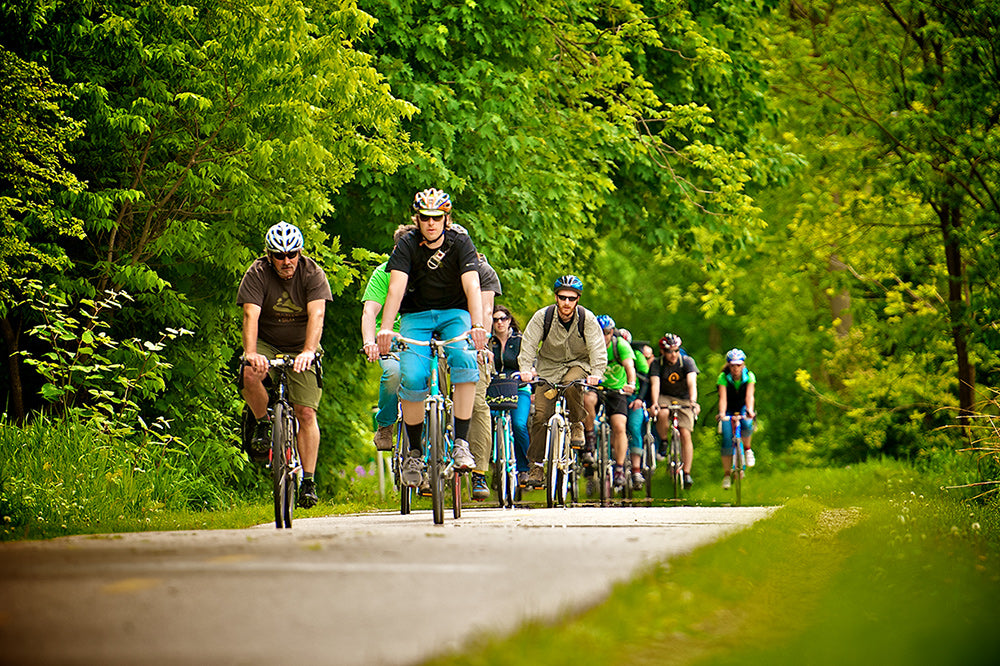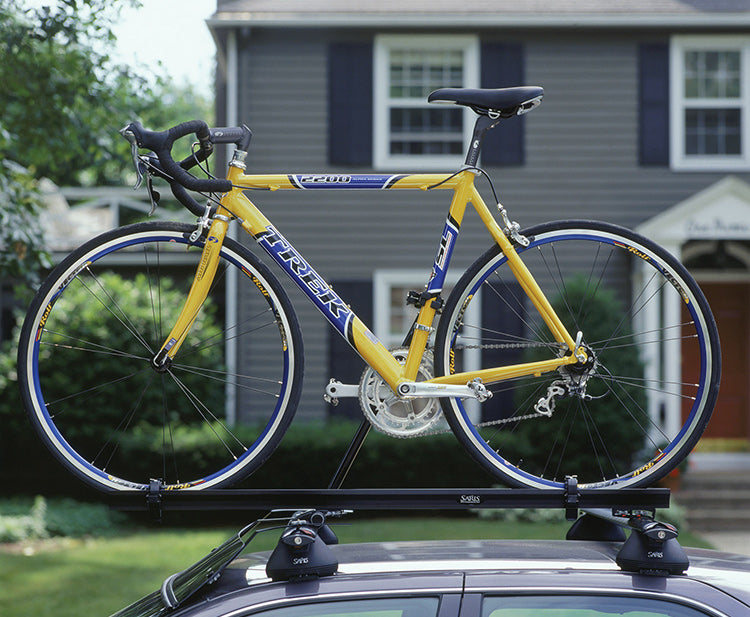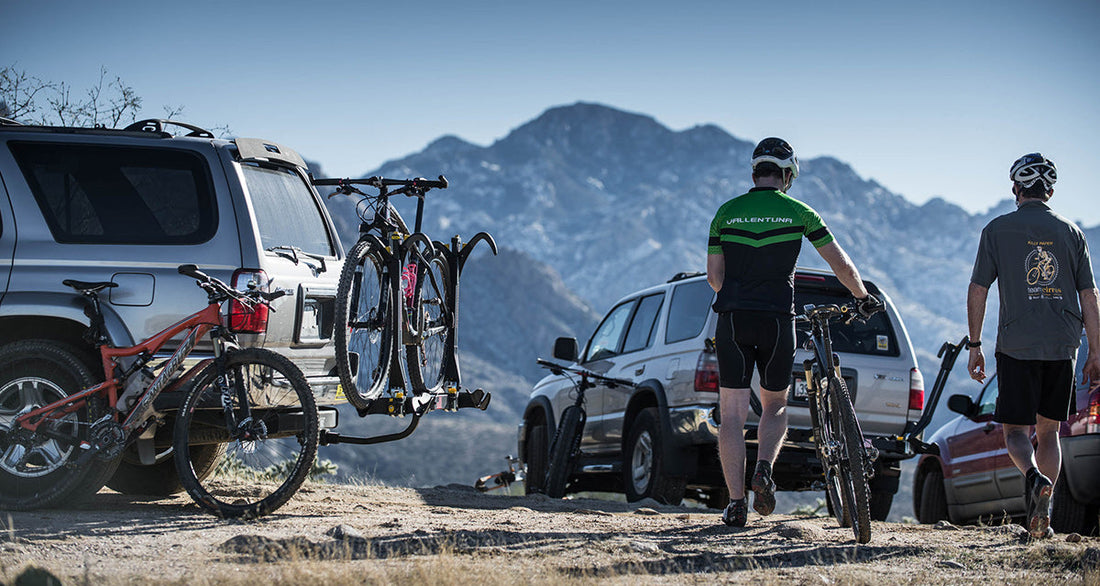You've got a bike and now you and your bicycle are ready to hit the road and explore. Welcome to the club! You're almost done making all these big, bike-related buying decisions – almost. Now it's time to buy a bike rack. We've developed this guide to help you find the right rack for you, your bike and your lifestyle.
Why should you listen to us? We developed the first trunk rack ever in 1976 and we've been helping cyclists shop for racks ever since. Our office is filled with cyclists focused solely on creating products for cyclists. If we won't use our products, we don't put them on the market. Period. With that in mind, we wanted to share four decades of knowledge with you so that you and your favorite bike can make the most of every ride – no matter the designation.

Let's get started!
If you are like most people, you'll likely start your search online. The challenge in this step is knowing what to search for. We suggest you do a number of different searches since the terms used for bike racks can vary. Common search terms include: "transport racks," "car racks," "bike racks" or "vehicle racks."
-
What do you want to carry? This is one of the most important questions in buying a car rack. If you are just looking to carry bikes - and bikes only - we suggest carrying bikes on the back of your car either on a trunk or hitch rack.
Bike-specific racks also tend to be more economical and have fewer easy-to-lose parts compared to a full system that integrates other sporting equipment.Of course, bike-only racks do not offer the ability to carry your skis, surfboard, kayak, etc. If you are in the market to carry more than just bicycles, a roof rack might be the right option for you. Both Thule and Yakima provide roof rack carriers that could help support your transport needs.
-
What type of bike do you want to transport? Factors such as bike weight, wheel size and frame material can all dictate which type of bike rack best accommodates your needs. Electronic bike enthusiasts will want a car rack that can support the weight of an e-bike (most of which weigh upwards of 50 lbs.), while fat bike owners will be looking for wheel scoops that can hold Moonlander sized treads. And if you have a collection of women's bikes, know that some racks will require the use of an accessory, like the Bike Beam to properly fit your bike on the rack. Similarly, if you have a family of bikes such as a tall adult bike and very small child's bike you'll want to take rack versatility into consideration. In short: take stock of your bike collection and think about how your fleet will impact your rack usage.

-
What's on your must-have list? Let's take a moment for self-reflection. Thinking about how you will interact with the rack, how you plan to use the bike rack and your overall lifestyle will help you with this query.A few examples of features to think about include ease of installation, rack weight, portability, security and storage space.
For instance, if you live in a 5th floor walk-up apartment – a lightweight rack may trump integrated locking features. Similarly, a family of four may need to haul various sized bikes – so versatility may rank higher than a rack that doesn't touch the frame. Or if you're short on storage space, a rack that folds flat could be more important than one that doesn't.
Buyer's tip: similar to a pros and cons list, write down your must-haves in one column and the features that are less important in another. Who knows, maybe you'll find a rack that meets everything on your list.
-
Do you want to increase your miles per gallon? Believe it or not, the choice of how you carry your bikes can save you on gas in a big way. That means fewer stops on the road and more bike riding.
Did you know that roof racks loaded with (or without) bikes can add a lot of drag and greatly decrease your car's efficiency? For example, How Stuff Works noticed a 27.3% drop in MPG on their test car equipped with a roof rack and a bike. Good to know!
-
What about intangibles? Once you've figured out your must-haves of the car rack, it's time to evaluate the intangibles. This could include invaluable items such as warranty length, customer service, corporate passions – such as advocacy work or trail maintenance - and manufacturing process. We recommend poking around the manufacturer's website to learn more about the company, their mission and how they treat their customers. Bonus points if the rack is eye pleasing. Why not get both style and functionality all in one?

-
Security: It's no secret, cycling can be an expensive sport. From the bike to the rack, the price tags add up. Once you take the plunge you want to be sure that both bicycle and car rack are not going anywhere. Take a look at the security measures to not only to keep the bikes secure on the rack, but also for the rack to the vehicle.
-
Trunk vs Hitch vs Roof: this is a biggie. When it comes to buying a car rack, there are three basic styles to choose from: trunk, hitch and roof. Each comes with its own list of benefits that we'll touch on below:
-
Trunk Racks

Trunk racks are great because they are incredibly versatile. They fit a wide variety of cars, are often smaller and easier to store and can even can be stowed away inside a car's trunk when not in use. For instance, our Bones trunk rack fits most vehicles making it easy to switch between cars or between friends. Plus, trunk racks are often more affordable. Additionally, transporting bikes on the rear of a car means easy access to your bikes once you reach your destination (i.e., no climbing or excessive reaching to get the bikes down).
-
Hitch Racks

Hitch-style racks are growing in popularity and it's no wonder why. Did you know that hitch racks used to be built so that was that you couldn't access the rear of your car with the rack installed?Now, most hitch racks are built with a tilt feature that allows you to access the rear of a vehicle without having to remove the bicycles. Hitch racks also do not touch the vehicle, thus eliminating the bike-to-car conflict and protecting your car's paint. And for those of you concerned about your bike's paint job, newer rack designs hold bikes in place by clamping the wheels and never touches your precious frame. Additionally, it's a breeze to install a hitch rack and accessories like the Locking Hitch Tite means your rack is securely locked to your vehicle.
-
Roof Racks

Historically, carrying a bike on the roof was seen as most protective to the bike since the bike is out of danger from other cars on the road.Roof rack systems also allow multi-sport enthusiasts the ability to carry more than just bicycles. However, one common downside is that the driver MUST heed caution when entering a garage, drive-thru or other low ceiling space.If you are smirking right now, perhaps it's because either you or someone you know has done this – once. The takeaway? It's imperative for roof rack owners to know their vehicle's height when fully loaded and pay attention to those clearance signs. To better compare roof rack systems, take a look at this write up from Rack Attack.
No matter your choice in rack style, be sure to refer to the manufacturer's fit guide to ensure that your new rack will work with your vehicle. And if you already know that you're in the market for a hitch rack, know that a hitch can be installed on almost any car. Places like U-Haul can help you determine if your car is hitch compatible and what type of hitch you may need.
-
Trunk Racks
-
Budget: Last but not least, budget certainly plays a role in the buying decision. Ask yourself, what's the maximum you'd like to spend? What compromises are you willing to make for the price? Just because a transport rack costs more doesn't mean it's the best one for you. Take a look at the features offered by the style of rack you're looking for and let that guide your decision.
What's the outcome?
After considering all the variables, here are the key takeaways for these three styles of bike transportation racks for cars.
Trunk Rack:
- Lightweight and easy to store.
- Ideal for bikes with a straight top bar.
- Keeps bike on the back of the car, which saves on gas mileage.
- Unlike hitch and roof systems, no extra part installation required.
- Fits a wide variety of vehicles out of the box.
Hitch Rack:
- Rack is easy to install.
- Allows for access to rear of vehicle.
- Doesn't touch your car.
- May not touch your bike's frame.
- Can be locked to vehicle.
- Keeps bike on the back of the car, which saves on gas mileage.
Roof Rack:
- Can haul more than just bicycles.
- Keeps bikes out of traffic height.
- Allows for access to rear of vehicle.
- License plate remains visible.
As you wrap-up this phase of research, we hope this guide has helped narrow your focus. So, what's next?How do you make the leap?We suggest taking note of the racks spotted on cars around town, heading down to your local bike shop to touch and feel the racks, and asking friends what bike racks they use and like.Plus, our team is always here to help. Good luck, enjoy, and happy riding!#longfortheride
